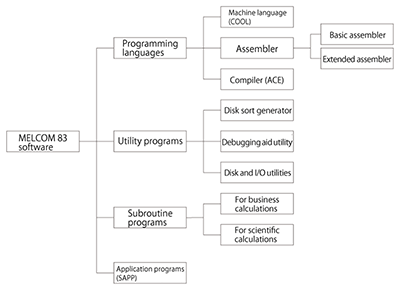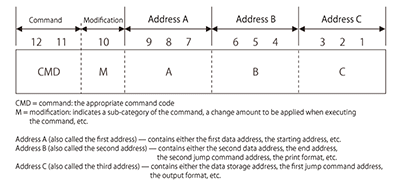The MELCOM 81, which was announced in 1968, was not furnished with any kind of basic software that could be called an operating system. Instead, it relied on a programming environment (language system) that used a decimal machine language called COOL (standing for “Customer-Oriented Optimum Language”). Even after Mitsubishi Electric introduced its first operating system (AOS) in 1974 on the MELCOM 80 Model 31, the company continued to release subsequent office computers based on COOL until the MELCOM 80 models 18 and 28 in 1978.
The COOL system description that follows is based on the version supplied with the MELCOM 83 announced in 1969. The diagram below illustrates the MELCOM 83’s software system including COOL.

- Home >
- Historical Computers in Japan >
- Office Computer OS >
- COOL
【Mitsubishi Electric】COOL

- (1) Programming languages
- COOL was the name of the machine language, but over time it was frequently used to refer to the architecture as well. On the MELCOM 83, COOL consisted of 34 commands (which would later be expanded to 40 commands) and adopted a three-address format expressed in decimal so that operators could easily recognize the commands. Each three-address command word was 12 decimal digits long, with a three-digit command field and three three-digit address fields.


- (2) Utility programs
- Supplied utility programs included loading programs, I/O programs, and block address move programs.
- (3) Subroutine programs
- Subroutines were provided for frequently used programs. Business calculation subroutines included income tax and year-end tax adjustments for payroll calculations, currency conversions, denomination conversions, and end-of-term calculations. Scientific calculation subroutines included square roots, cubic roots, trig functions, inverse trig functions, exponential functions, log functions, and floating-point arithmetic calculations.
- (4) Application programs
- SAPP (standing for “standard application program package”) was a package of standard industry-specific and task-specific programs. After installing the system, users could quickly and easily design their own specific processing methods and I/O methods based on SAPP.
All Rights Reserved, Copyright (C) Information Processing Society of Japan
